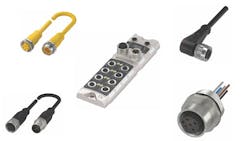Making the Right Connection: Navigating the World of Industrial Connectors
In industrial manufacturing, it’s no secret that efficiency hinges on the seamless integration of components. With countless parts working together in a single system, it’s imperative that each one functions optimally with those around it.
That’s why connectors play a crucial role in many industrial applications. When they appropriately match system needs and requirements, they provide reliable communication, power transfer and system functionality. In industries like discrete manufacturing, connectors must support precise automation and high-speed operations, whereas batch manufacturing demands connectors that withstand frequent disconnections and exposure to environmental factors like moisture, dust and temperature fluctuations.
Because connectors have so many duties to fulfill, there is an overwhelming number of choices on the market, causing the seemingly simple task of selecting, purchasing and integrating a connector to become needlessly complex or challenging. The sheer variety of configurations, materials, specifications and vendors can leave manufacturers struggling to determine not only the best-fit connector for their application but also where to source each specific connector.
Without careful consideration of each connector’s functions and properties, the wrong choice can lead to system inefficiencies, unplanned downtime and costly replacements. Even the right choice may result in multiple sources of connectors, potentially causing compatibility issues such as mismatched pin configurations, inconsistent quality standards or increased troubleshooting complexity, as well as supply chain difficulties like high costs for small order quantities and increased shipping expenses.
With so much to consider when selecting the right connector, manufacturers can benefit from tailored selection strategies and reliable distribution from trusted engineering partners.
Understanding connectors as an engineering partner
When aiding and supporting a manufacturer in the selection process of industrial connectors, an engineering partner must prioritize several key factors. Because connectors play a vital role in power distribution and data communication, electrical performance must be a top priority. Voltage and current ratings must align with system demands to ensure safe and efficient power transmission and prevent issues such as overheating, arcing or voltage drops.
A connector’s physical design also directly impacts system reliability and ease of use. The number of pins, contact arrangement and mating cycles determine how well a connector will integrate into an application.
In automation-heavy environments, data integrity is equally critical because high-speed industrial networks rely on connectors that can support fast, stable transmission while minimizing interference. Shielding, impedance matching and compliance with communication protocols such as Profinet and Ethernet/IP help maintain signal integrity and prevent disruptions.
A connector’s physical design also directly impacts system reliability and ease of use. The number of pins, contact arrangement and mating cycles determine how well a connector will integrate into an application. In high-use environments, connectors must withstand thousands of mating cycles without degrading performance. Secure locking mechanisms prevent accidental disconnection, especially in equipment subject to vibrations or movement. In addition, tool-free, modular or pre-assembled connectors simplify installation and maintenance, reducing setup time while minimizing the risk of wiring errors.
A strategic approach to connector selection
With an overwhelming number of connectors available and many factors to consider, manufacturers need a strategic approach to selection. A well-planned connector strategy starts with understanding application requirements and environmental factors.
Once manufacturers establish their needs, the next step may involve relying on expert guidance from trusted suppliers and engineering partners. These partnerships can help streamline the decision-making process, ensuring that the chosen connectors meet industry standards, withstand the manufacturer’s environmental conditions and integrate seamlessly into their existing systems.
For example, the Evolution Connects Stocking Program by Evolution Motion Solutions offers direct, tailored engineering support when selecting best-fit connectors that meet 85-95% of system requirements in industrial manufacturing industries. By working with knowledgeable suppliers, companies can avoid common pitfalls in connector selection, such as mismatched specifications and unnecessarily complex BOMs.
A strategic approach to connector selection is not just a technical consideration — it’s a business decision that impacts efficiency, reliability and long-term performance.
Kylie Ferguson is with Evolution Motion Solutions.

